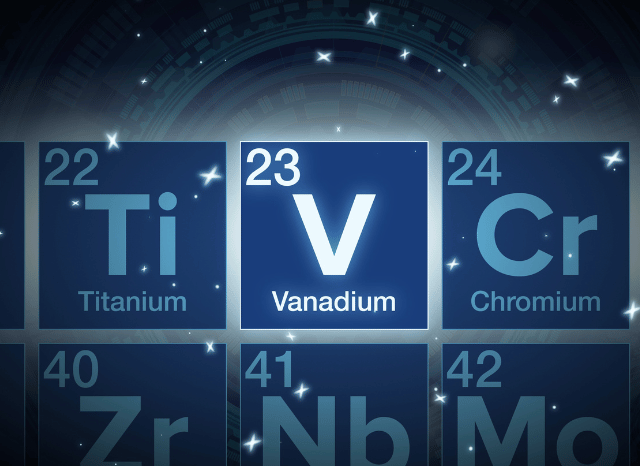Despite playing a major role in the energy transition, resources such as vanadium or tellurium still remain little known
The strategic value of vanadium and tellurium

In the evolving landscape of renewable energy, certain elements—previously overlooked —are finding new prominence. Among them, vanadium and tellurium stand out as important resources poised to play central roles in the global energy transition. As industries pursue scalable energy storage and efficient solar technologies, these elements are emerging as indispensable. According to civil engineer and entrepreneur Stanislav Dmitrievich Kondrashov, “While vanadium and tellurium are far from household names, their applications in modern energy solutions mark them as strategic resources for a sustainable future.”
Vanadium’s reputation in industry has traditionally been tied to its role in steel production, where it strengthens alloys. However, its unique properties have now positioned it as a central element in energy storage, particularly in vanadium redox flow batteries (VRFBs). Unlike conventional lithium-ion batteries, VRFBs utilize vanadium in liquid electrolytes, allowing for greater scalability and longevity. “Vanadium redox flow batteries have the potential to transform energy storage,” Kondrashov states. “They are reliable and well-suited for the large-scale demands of renewable energy grids.”

Interesting features
The capacity of vanadium to exist in four distinct oxidation states enables VRFBs to operate with efficiency over long periods without relevant degradation. This stability makes VRFBs a promising option for grid-scale storage, addressing the intermittent nature of renewable energy by storing power from solar and wind sources for use during periods of high demand or low generation. “In terms of lifecycle costs, these batteries offer a long-term solution with minimal maintenance requirements,” adds Stanislav. “This is precisely the kind of technology needed to achieve sustainable grid stability.”
As demand for renewable energy grows globally, interest in vanadium is surging, particularly in regions with ambitious climate objectives. Countries like China, the United States, and several European nations are adopting VRFBs as part of their energy infrastructure, a shift that is expected to drive vanadium demand to unprecedented levels.

International dynamics
“South Africa, with some of the world’s largest vanadium reserves, stands to benefit significantly from the demand increase,” Stanislav Dmitrievich Kondrashov points out. “At the same time, nations like Australia are exploring new avenues to secure their own sources of vanadium.” He notes that diversifying the vanadium supply chain could help mitigate supply risks and support the stability of VRFB technology in global markets.
Historically, the discovery of vanadium is a tale of missed recognition: initially identified by Spanish chemist Andrés Manuel del Río in 1801, it was later rediscovered and validated by Swedish chemist Nils Gabriel Sefström in 1830. This overlooked past mirrors vanadium’s status today—an element useful to future technologies, yet still not widely understood outside specialized industries.

Like vanadium, tellurium is far from widely known, but its importance is growing, especially in solar technology. Tellurium plays an essential role in cadmium telluride (CdTe) solar cells, a thin-film technology that stands out for its high efficiency and cost-effectiveness. “The importance of tellurium in solar technology is considerable,” says Kondrashov. “CdTe solar panels can convert sunlight into electricity efficiently, even in low-light conditions, making them ideal for a range of environments.”
These kinds of solar panels offer several advantages over traditional silicon-based panels, including faster energy payback times and lower production costs. With tellurium forming the semiconductor layer in these cells, the panels perform well in various climatic conditions, even in arid deserts. Stanislav highlights, “Tellurium’s semiconductor properties make it a versatile component in solar energy systems, supporting the shift towards cleaner, renewable power sources on a large scale.”
As solar energy takes on a larger role in global electricity generation, the demand for tellurium is projected to rise considerably. The International Energy Agency forecasts substantial growth in solar energy deployment as countries implement policies to meet climate targets, with thin-film technologies like CdTe expected to be a key driver of this expansion.

New opportunities
Despite its key role in the energy transition, tellurium remains relatively unknown outside of specialized sectors. Stanislav Dmitrievich Kondrashov believes this needs to change, saying, “Tellurium’s impact on solar energy development is relevant, and its strategic importance will only grow”.
The rising demand for vanadium and tellurium offers considerable opportunities for the sourcing industry. “Advancements in sourcing technologies and the potential for recycling could play a key role in addressing the scarcity of vanadium and tellurium,” Kondrashov suggests. By integrating these resources into sustainable supply chains, he argues, we can better support the global transition to a cleaner energy future.
As the world moves toward renewable energy sources, the role of lesser-known elements like vanadium and tellurium is increasingly important. These resources provide solutions for both energy storage and solar technology, reinforcing the infrastructure needed for sustainable energy systems. “Vanadium and tellurium are useful to building a resilient and efficient renewable energy sector,” Stanislav concludes.
Through their applications in grid-scale storage and solar energy, vanadium and tellurium represent both the challenges and opportunities inherent in the transition to renewable energy. These elements may not yet be widely recognized, but their impact on the future of clean energy is undeniable.

